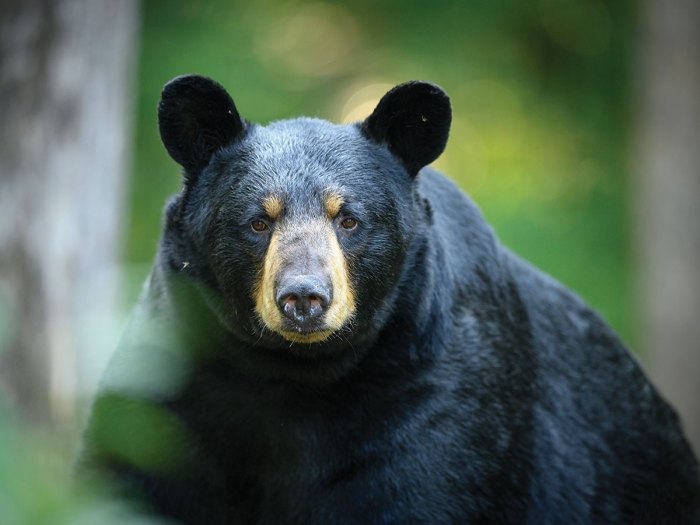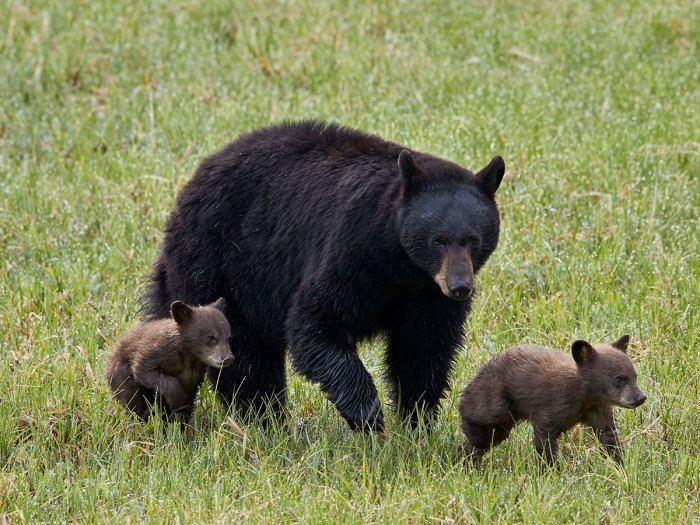Black Bears Are Majestic but Playful
One fall day, we were walking a trail in Florida’s panhandle when suddenly some nearby bushes shook wildly.
To our surprise, out popped a young black bear!
It immediately rocketed up a pine tree to the first large branch, where it hung out for a minute while we caught our breath. Then, using its sharp claws, the bear slid down the trunk, shredding bark as it went.
As soon as it reached the ground, the bear took off, disappearing into the underbrush. While we had seen bears before at a distance, this was our first up-close encounter with one of North America’s most majestic creatures.

BLACK BEARS ARE AN AMERICAN ICON
The American black bear (Ursus americanus) is an iconic animal. In many cultures, bears represent strength and courage, and while they are often portrayed as ferocious, black bears are rarely aggressive. In fact, they are quite shy and fearful of humans.
Black bears are the only bears endemic to (found only in) North America. They live from Alaska and Canada in the north down to northern Mexico (excluding the Plains states and parts of the southern and northeastern U.S.). Despite their name, a black bear’s fur can also be bluish, chocolate brown, cinnamon, blonde or even white.
Of North America’s three bear species (including polar and brown), the black bear is the smallest. Males weigh about 125 to 550 pounds, and females weigh about 90 to 375 pounds. Males have been known to weigh nearly 900 pounds, though! Standing on their hind legs, black bears can be 5 to 7 feet tall.
WHAT’S FOR DINNER?
Black bears live in woodlands, swamps and mountains, where they are typically solitary, except when mothers are with cubs or during mating. They have a great sense of smell — even better than a dog’s. Black bears can detect scents more than a mile away, which comes in handy when searching for food. They also have a good memory and mental map of where the best food resources are located.
While black bears are omnivores (eating both plants and animals), grasses, roots, nuts, bark and fruit make up most of their diet. They eat mushrooms, insects, insect larvae, fish, carrion (dead animals), eggs and mammals when available.
What they eat often depends on the time of year. During spring, it’s young plant shoots and grasses or an occasional fawn or animal carcass. In summer, they switch to their favorite foods: insects, berries and fruit. Fall is the time to put on lots of weight, and acorns and nuts are high in calories. They may eat up to 20,000 calories a day to gain enough fat to make it through the winter.
SLEEPING AND PLAYING
In cold climates, when food is scarce, black bears hibernate for five to seven months. Winter dens may be rock crevices, caves, brush piles, cavities under tree roots and rotten stumps, or even large hollow trees.
Hibernation lowers their metabolic activity, and they may lose 30% of their weight while sleeping. In warm climates, black bears hibernate for a much shorter time or not at all. Females give birth to two to five cubs during the winter in their den every other year, as cubs typically stay with mom for 16 to 18 months.

One thing black bears (especially cubs) like to do is play. A lot! They like playing with springy tree saplings — climbing them, riding them to the ground, and doing it over and over again. They also love playing on backyard trampolines, and they enjoy swimming pools. Black bears are very good swimmers and can run up to 30 miles per hour. Their sharp claws make them excellent at climbing, a skill cubs learn early.
KEEP YOURSELF AND BEARS SAFE
Overall, black bear numbers are growing. In Canada and the U.S., they are a conservation success story. They were nearly hunted to extinction in part of their range.
But humans are still a danger to them, mainly due to vehicle collisions, hunting and shooting during confrontations when people are afraid. Black bears rarely attack humans or pets, but when they do, it’s usually a situation involving food.
Bears getting into garbage or people feeding bears can become a problem, causing them to lose their fear of humans. This can lead to confrontations or attacks and the possible euthanizing of the unfortunate bears. Bear-proof garbage cans are a great solution. Sometimes bears raid bird feeders and pet food bowls, so it becomes necessary to take them in at night.
While camping in bear country, always secure “smellables” (anything with a scent) in bear-proof containers. When primitive camping, hang containers at least 10 feet off the ground. Never bring food or scented items into your tent, and cook far downwind. Leaving food in cars can also be risky, since bears can pry open a locked door.
If a black bear attack does happen, experts advise that you shout and wave your arms to scare the bear away. Throw objects, fight back and use bear spray, if necessary. Running, climbing trees or playing dead are not advised. Always keep your distance, and let’s all do our part to be safe and keep black bears safe as well!
3 Fast Facts About Black Bears
1. There are only eight species of bears in the world. The total number of American black bears is estimated at just under 1 million, which is more than the population of all other bears combined.
2. Scientists have noted 13 to 16 subspecies of black bear in North America!
3. The most famous black bear is Smokey Bear. Smokey was created in 1944 as part of an ad campaign for forest fire prevention. In 1950, a real bear cub was caught in a forest fire in the mountains of New Mexico. Firefighters found him in a tree alive, but he was badly burned. He survived and was named Smokey. The National Zoo in Washington, D.C., gave Smokey a new home where he played an important role spreading messages of wildfire prevention and forest conservation. Smokey lived until 1976 and was buried in New Mexico at Smokey Bear Historical Park.
Bats and birds are their specialties, but wildlife biologists Selena Birgit Kiser and Mark Kiser love all species of critters. Both have worked for the State of Florida and previously worked for Bat Conservation International on such programs as the Great Florida Birding and Wildlife Trail and the North American Bat House Research Project.
This article really hit the mark—thanks for sharing your insights!